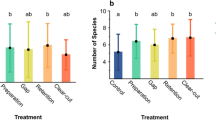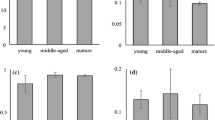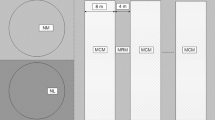Abstract
The early effects of femel-cutting (removing 20% of the trees) and small scale clear-cutting on ground-living spiders in a Norway spruce (Picea abies (L.) Karst.) forest in Southern Germany were investigated. The study was carried out as BACIP (before and after, control-impact, many paired samplings) study: Spiders were sampled during the pre-treatment year, the year of cutting, and the year after cutting. In total 7101 individuals were sampled, of which 4530 individuals were identified, 4468 were adult and 2633 individuals were juvenile. We identified 107 species, but a single species, Coelotes terrestris, dominated the control (spruce stand) comprising up to 49% of the total identified individuals. Clear-cutting changed the species composition in the traps, while the first step in femel-cutting preserved it. The number of individuals of the families Linyphiidae, Amaurobiidae, Agelenidae and Clubionidae decreased drastically within the 2 years after the clear-cutting, while the Lycosidae became numerically dominant in the clear-cut stands. The number of individuals with the following characterisation decreased significantly after clear-cutting: Small (<3.0 mm) and large spiders (>10.5 mm), web builders, ‘forest habitat species’, species favouring hygrophilic to medium moisture conditions, and preferences to live below ground or in and on the moss layer. On the other hand, middle-sized spiders, free hunters, ‘open habitat species’, spiders favouring dry conditions or that are euryoecious, preferring patterns covered by grasses or uncovered patches, increased in number. Clear-cut habitats with dense spruce regeneration showed a delayed and less pronounced response. With femel-cutting, species composition of ground-living spider communities may be preserved during the first step of regeneration of mature forest stands.
Similar content being viewed by others
References
Anonymous 2004. Erfolgreich mit der Natur. Ergebnisse der zweiten Bundeswaldinventur in Bayern. – Bayerische Landesanstalt für Wald und Forstwirtschaft (LWF). www. lwf.bayern.de
Altegrim O. and Sjöberg K. (2004). Selective felling as a potential tool for maintaining biodiversity in managed forests. Biodivers. Conserv. 13: 1123–1133
Altegrim O. and Sjöberg K. (1995). Effects of clear-cutting and selective felling to Swedish Boreal coniferous forest: response of invertebrate taxa eaten by birds. Entomol. Fennica 6: 79–90
Bennett L.T. and Adams M.A. (2004). Assessment of ecological effects due to forest harvesting: approaches and statistical issues. J. Appl. Ecol. 41:585–598
Blick T. and Scheidler M. (2003). Rote Liste gefährdeter Spinnen (Arachnida: Araneae) Bayerns. Bayerische Landesamt für Umweltschutz 166: 308–321
Brand C., Höfer H. and Beck L. (1994). Zur Biologie eines Buchenwaldbodens, 16. Die Spinnenassoziation einer Windbruchfläche. Carolinea 52: 61–74
Buddle C.M., Spence J.R. and Langor D.W. (2000). Succession of boreal forest spider assemblages following wildfire and harvesting. Ecography 23:424–436
Bultman T.L., Uetz G.W. and Brady A.R. (1982). A comparison of cursorial spider communities along a successional gradient. J. Arachnol. 10:23–33
Butterbach-Bahl K., Gasche R., Huber C., Kreutzer K. and Papen H. (1998). Impact of N-input by wet deposition on N-trace gas fluxes and CH4-oxidation in spruce forest ecosystems of the temperate zone in Europe. Atmos. Environ. 32:559–564
Coyle F.A. (1981). Effects of clearcutting on the spider community of a southern Appalachian forest. J. Arachnol. 9:85–298
Curry S.J., Humphreys W.F., Koch L.E. and Main B.Y. (1985). Changes in arachnid communities resulting from forestry practices in Karri Forest, south-west Western-Australia. Austr. Forest Res. 15:469–480
Curtis D.J. (1980). Pitfalls in spider community studies (Arachnidae, Aranae). J. Arachnol. 8:271–280
Docherty M. and Leather S.R. (1997). Structure and abundance of arachnid communities in Scots and lodgepole pine plantations. For. Ecol. Manage 95:197–207
Duffey E. (1978). Ecological strategies in spiders including some characteristics of species in pioneer and mature habitats. Symp. Zool. Soc. Lon 42:109–123
Dumpert K. and Platen R. (1985). Zur Biologie eines Buchenwaldbodens. 4. Die Spinnenfauna. Carolinea 42:75–106
Engel K. (1999). Analyse und Bewertung von Umbaumaßnahmen in Fichtenreinbeständen anhand ökologischer Gilden der Wirbellosen-Fauna. Wissenschaft & Technik Verlag, Berlin
Gessler A., Schneider S., von Sengbusch D., Weber P., Hanemann U., Huber C., Rothe A., Kreutzer K. and Rennenberg H. (1998). Field and laboratory experiments on net uptake of nitrate and ammonium the roots of spruce (Picea abies) and beech (Fagus sylvatica) trees. New Phytol. 138:275–285
Geiger R. 1961. Das Klima der bodennahen Luftschicht, 4th ed. Braunschweig, 646 pp
Heimer S. and Nentwig W. (1991). Spinnen Mitteleuropas. Parey, Berlin
Heydemann B. (1964). Die Carabiden der Kulturbiotope von Binnenland und Nordseeküste – ein ökologischer Vergleich (Coleopt., Carabidae). Zool. Anz. 172:4–86
Hill M.O. and Gauch H.G. (1980). Detrended correspondence analysis: an improved ordination technique. Vegetatio 42:47–58
Huber C. and Kreutzer K. (2002). Three years of continuous measurements of atmospheric ammonia concentrations over a forest stand at the Höglwald site in southern Bavaria. Plant Soil 240:13–22
Huber C., Oberhauser A. and Kreutzer K. (2002). Deposition of ammonia to the forest floor under spruce and beech at the Höglwald site. Plant Soil 240:3–11
Huber C. and Baumgarten M. (2005). Early effects of forest regeneration with selective and small scale clear-cutting on ground beetles (Coleoptera, Carabidae) in a Norway spruce stand in Southern Bavaria (Höglwald). Biodiv. Conserv. 14:1989–2007
Huber C., Kreutzer K., Röhle H. and Rothe A. (2004a). Response of artificial acid irrigation, liming, and N-fertilisation on elemental concentrations in needles, litter fluxes, volume increment, and crown transparency of a N saturated Norway spruce stand. For. Ecol. Manage 200:3–21
Huber C., Weis W., Baumgarten M. and Göttlein A. (2004b). Spatial and temporal variation of seepage water chemistry after femel and small scale clear-cutting in a N-saturated Norway spruce stand. Plant Soil 267:23–40
Huhta V. (1971). Succession in the spider communities of the forest floor after clear-cutting and prescribed burning. Ann. Zool. Fennici 8:483–542
Huhta V., Karprinen E., Nurminen M. and Valpas A. (1967). Effect of silvicultural practices upon arthropod, annelid and nematode populations in coniferous forest soil. Ann. Zool. Fennici 4:87–143
Huhta V., Nurminen M. and Valpas A. (1969). Further notes on the effect of silvicultural practices upon the fauna of coniferous forest soil. Ann. Zool. Fennici 6:327–334
Jennings D.T., Houseaert M.W., Dondale C.D. and Redner J.H. (1988). Spiders (Araneae) associated with strip-clearcut and dense spruce-fir forests of Maine. J. Arachnol. 16:55–70
Jones D. 1990. Der Kosmos-Spinnenführer, Mitteleuropäische Spinnen und Weberknechte. – Franckh‘sche Verlagshandlung
Junker E.A., Ratschker U.M. and Roth M. 2000. Impacts of silvicultural practice on the ground living-spider community (Arachnidae: Araneae) of mixed mountain forest in the Chiemgau Alps (Germany). In: Gajdos P. and Pekar S. (eds), Proceedings of the 18th European Colloquium of Arachnology, Stara Lesna, 1999. Ekologia (Bratislava) 19, Supplement 3, pp. 107–117
Kajak H. (1965). An analysis of food relations between the spiders – Araneus cornutus Clerck and Araneus quadratus Clerck – and their prey in meadows. Ekol. Polska A 12:717–764
Kreutzer K. (1995). Effects of forest liming on soil processes. Plant and Soil 168–169:447–470
Kreutzer K. and Bittersohl J. (1986). Investigations about the effects of acid deposition and compensative liming on the forest. Forstw. Cbl. 105: 273–282 (in German)
Kreutzer K. and Weiss T. (1998). The Höglwald field experiment – aims, concept and basic data. Plant Soil 199:1–10
Larsson S. and Danell K. (2001). Science and the management of boreal forest biodiversity. Scand. J. For. Res. Suppl. 3:5–9
Likens G.E. (2001). Biogeochemistry, the watershed approach: some uses and limitations. Marine Freshw. Res. 52:5–12
Luff M.L. (1975). Some features influencing the efficiency of pitfall traps. Oecologia 19:345–357
McCune B., Grace J.B. and Urban D.L. (2002). Analysis of Ecological Communities. MjM Software Design, Glenaden Beach, Oregon, USA, ISBN 0-9721290-0-6, www.pcord.com
McIver J.D., Parsons G.L. and Moldenke A.R. (1992). Litter spider succession after clear-cutting in a western coniferous forest. Can. J. For. Res. 22:984–992
Moulder B.C. and Reichle D.E. (1972). Significance of spider predation in the energy dynamics of forest arthropod communities. Ecol. Monogr. 42:473–498
Okansen J. and Minchin P.R. (1997). Instability of ordination results under changes in input data order: explanations and remedies. J. Veg. Sci. 8:447–454
Pajunen T., Haila Y., Halme E., Niemelä J. and Punttila P. (1995). Ground-dwelling spiders (Arachnida, Araneae) in fragmented old forests and surrounding managed forests in southern Finland. Ecography 18:62–72
Pearce J.L., Venier L.A., Eccles G., Pedlar J. and McKenney D. (2004). Influence of habitat and microhabitat on epigeal spider (Araneae) assemblages in four stand types. Biodiv. Conserv. 13:1305–1334
Phillips I.D. and Cobb T.P. (2005). Effects of habitat structure and lid transparency on pitfall catches. Environ. Entomol. 34:875–882
Platen R., Moritz M., Broen B. v., Bothmann I., Bruhn K. and Simon U. 1991. Liste der Webspinnen- und Weberknechtarten (Arach.: Araneida, Opilionida) des Berliner Raumes und ihre Auswertung für Naturschutzzwecke (Rote Liste). In: Auhagen A., Platen R., and Sukopp H. (eds), Rote Liste der gefährdeten Pflanzen und Tiere in Berlin. Landschaftsentwicklung und Umweltforschung S 6: 169–205
Ratschker U.M. and Roth M. (2000). Studies on ground dwelling spiders (Araneae) of agrarian habitat types in Northeast Germany: ecological and nature conservation aspects. Ekologia-Bratislava 19:213–225 Suppl. 3, 2000
Riechert S.E. and Gillespie R.G. 1986. Habitat choice and utilization in web-building spiders. In: Shear, W.A. (ed.), Spiders: Webs, Behaviour, and Evolution. Stanford University Press, pp. 23–48
Riecken U. (1999). Effects of short-term sampling on ecological characterisation and evaluation of epigeic spider communities and their habitats for site assessment studies. J. Arachnol. 27:189–195
Robinson J.V. (1981). The effect of architectural variation in habitat on a spider community: an experimental field study. Ecology 62:73–80
Rothe A., Huber C., Kreutzer K. and Weis W. (2002). Deposition and soil leaching in stands of Norway spruce and European beech: results from the Höglwald research in comparison with other case studies. Plant Soil 240:33–45
Rothe A. and Mellert K.H. (2004). Effects of forest management on nitrate concentrations in seepage water of forests in southern Bavaria, Germany. Water Air Soil Pollut. 156:337–355
Siira-Pietikäinen A., Pietikäinen J., Fritze H. and Haimi J. (2001). Short-term responses of soil decomposer communities to forest management: clear felling versus alternative forest harvesting methods. Can. J. For. Res. 31:88–99
Siira-Pietikäinen A., Haimi J. and Siitonen J. (2003). Short-term response of soil macroarhropod community to clear felling and alternative forest regeneration methods. For. Ecol. Manage 172:339–353
Spence J.R. (2001). The new boreal forestry: adjusting timber management to accommodate biodiversity. Trends Ecol. Evol. 16:591–593
Tilman D. (1989). Ecological experimentation: strengths and conceptual problems. In: Likens G.E. (eds) Long Term Studies in Ecology. Springer Verlag, New York, pp. 136–157
Turnbull A.L. (1966). A population of spiders and their potential prey in an overgrazed pasture in eastern Ontario. Canad. J. Zool. 44:557–583
Uetz G.W. (1979). The influence of variation in litter habits on spider communities. Oecologia 40:29–42
Uetz G. W. 1991. Habitat structure and spider foraging. In: Bell S.S., McCoy E.D. and Mushinsky H.R. (eds), Habitat Structure: The Physical Arrangement of Objects in Space, Chapmann and Hall, pp. 325–348
Uetz G.W. and Unzicker J.D. (1976). Pitfall trapping in ecological studies of wandering spiders. J. Arachnol. 3:101–111
Weis W., Huber C. and Göttlein A. (2001). Regeneration of mature Norway spruce stands. The impact of clear cutting and selective cutting on seepage water quality and soil fertility. Sci. World 1(S2):493–499
Acknowledgements
The work was funded by the Bundesministerium für Bildung, Forschung und Technologie (BMBF), under contract number 0339733A. The authors are very grateful to Helmut Stumpf, Würzburg, Germany for the identification of spider species and the safekeeping of the specimens. We thank Dr Jacquie van der Waals, University of Pretoria, for editing of the manuscript and two anonymous reviewers for their comments to improve the manuscript.
Author information
Authors and Affiliations
Corresponding author
Rights and permissions
About this article
Cite this article
Huber, C., Schulze, C. & Baumgarten, M. The effect of femel- and small scale clear-cutting on ground dwelling spider communities in a Norway spruce forest in Southern Germany. Biodivers Conserv 16, 3653–3680 (2007). https://doi.org/10.1007/s10531-006-9004-2
Received:
Accepted:
Published:
Issue Date:
DOI: https://doi.org/10.1007/s10531-006-9004-2




